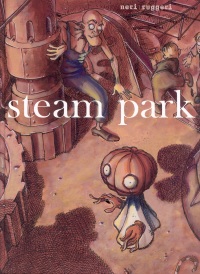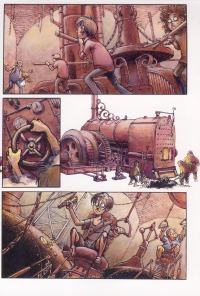| ________________
CM . . .
. Volume XIII Number 11 . . . .January 19, 2007 
 |
Steam Park.
Filippo Neri. Illustrated by Piero Ruggeri.
Vancouver, BC: Simply Read Books, 2006.
44 pp., cloth, $19.95.
ISBN 1-894965-63-9.
Grades 3-7 / Ages 8-12.
Review by Sylvia Pantaleo.
***½ /4
|
| |
|

The verso of the first opening of this graphic novel style picturebook has four horizontal panels of equal size. On the first page, readers view a zeppelin named Dream Tour as it sails toward Luna Park. The dirigible's view from above reveals that the amusement park is void of human activity. The last panel on the recto of the first opening foreshadows the ill-omened events as the silhouette of the zeppelin floats across billowing, storm-like clouds.
As the dirigible sails off into the distance, five children full of anticipation and excitement approach Luna Park. They purchase tickets for the "Hor-Hor Tun" from a sneering and evil-looking man and enter the "Tunnel." The children board a roller coaster and begin a ride that quickly changes from exhilarating to terrifying as the cars on the track detach from each other. The children's cars travel in opposite directions, and two boys eventually crash into one of the machinery rooms. The boys quickly find themselves pursued and caught by the nefarious man who sold them the tickets for the tunnel ride. The kidnapper confines the boys to a room, but, when he pulls a lever outside of their vault, an electrical short circuit brings to life some of Luna Park's inanimate creatures, including a flying/floating jack-o-lantern/pumpkin headed creature with bulbous eyes (hereafter referred to as Pumpkin Head).
Thanks to a disgusting-looking rat, Pumpkin Head finds its way outside of the building into the moonlit night. In a nearby carnival trailer, a former clown consumes quantities of alcohol. When the clown sees Pumpkin Head peering in his window, he goes outside to investigate. Once the two characters meet, Pumpkin Head convinces the clown to follow him back into the amusement park, and, after a mishap involving an elephant, the duo discover a trapdoor on the merry-go-round. Below, they discover the children working as slaves to keep the steam machinery operating to run the rides. Not surprisingly, the attempted rescue of the children by the clown and Pumpkin Head is interrupted by the ticket-selling rogue. He proceeds to inflict bodily harm on the clown, and a powerful punch by the villain sends the clown sailing across the room. He hits another electrical panel, and the impact causes a second short circuit, resulting in many more of the inanimate amusement park creepy creatures coming to life.
 Several subsequent panels in the picturebook depict the physical action-packed conflict between the villain and the amusement park creatures (typical of comic book fight scenes), but the despicable amusement park operator is outnumbered. As morning dawns, a bird sings and a zeppelin floats across the sky. In the next panel, smiling people are moving about the park, going on rides and purchasing food. A juggling clown, who looks very familiar, gives a boy a few balls to hit a bear-like creature, the target in one of the carny booths. The last close-up panel reveals the identity of the target … someone who deserves this retribution.
Several subsequent panels in the picturebook depict the physical action-packed conflict between the villain and the amusement park creatures (typical of comic book fight scenes), but the despicable amusement park operator is outnumbered. As morning dawns, a bird sings and a zeppelin floats across the sky. In the next panel, smiling people are moving about the park, going on rides and purchasing food. A juggling clown, who looks very familiar, gives a boy a few balls to hit a bear-like creature, the target in one of the carny booths. The last close-up panel reveals the identity of the target … someone who deserves this retribution.
The predominantly earth-toned and blue-hued illustrations appropriately communicate an ominous and mysterious mood. The illustrations on the glossy pages are outlined in black, as are the panels. The shifting perspectives evident in the illustrations include bird's-eye, worm's eye, close-up, distance, frontal, side and behind. Significance of meaning is conveyed effectively by the changing layout of the panels. For example, the recto of the third opening contains four vertical panels the height of the page. This particular structure communicates the emotions and experiences of the children as they journey on the roller coaster through the Tunnel. Some panels are superimposed on background illustrations. For example in the tenth opening, a horizontal panel is superimposed on two vertical panels, and the latter are layered on an illustration that fills approximately two-thirds of the page and bleeds to the edges. The layout of panels conveys further information about the simultaneity of actions and pacing of events. Paradoxically, no panels contain text depicting sound effects, perhaps heightening the significance of the children's fear and the strange and somewhat frightening events that occur in Luna Park. The one speech balloon in a panel on the verso of the sixth opening contains five symbols that convey the villain's thoughts/words when he burns his hand on the lever that short circuits.
Initially, Filippo Neri used his drawing skills in the advertising and fashion fields. He attended courses in comics by Piero Ruggeri in 1994, and, in 2000, he and Ruggeri collaborated on several projects, including Steam Park.
Highly Recommended.
Sylvia Pantaleo teaches courses in language arts in the Faculty of Education, the University of Victoria, in Victoria, BC.

To comment
on this title or this review, send mail to cm@umanitoba.ca.
Copyright © the Manitoba Library Association. Reproduction for personal
use is permitted only if this copyright notice is maintained. Any
other reproduction is prohibited without permission.
NEXT REVIEW |
TABLE OF CONTENTS FOR THIS ISSUE
- January 19, 2007.
AUTHORS |
TITLES |
MEDIA REVIEWS |
PROFILES |
BACK ISSUES |
SEARCH |
CMARCHIVE |
HOME |

 Several subsequent panels in the picturebook depict the physical action-packed conflict between the villain and the amusement park creatures (typical of comic book fight scenes), but the despicable amusement park operator is outnumbered. As morning dawns, a bird sings and a zeppelin floats across the sky. In the next panel, smiling people are moving about the park, going on rides and purchasing food. A juggling clown, who looks very familiar, gives a boy a few balls to hit a bear-like creature, the target in one of the carny booths. The last close-up panel reveals the identity of the target … someone who deserves this retribution.
Several subsequent panels in the picturebook depict the physical action-packed conflict between the villain and the amusement park creatures (typical of comic book fight scenes), but the despicable amusement park operator is outnumbered. As morning dawns, a bird sings and a zeppelin floats across the sky. In the next panel, smiling people are moving about the park, going on rides and purchasing food. A juggling clown, who looks very familiar, gives a boy a few balls to hit a bear-like creature, the target in one of the carny booths. The last close-up panel reveals the identity of the target … someone who deserves this retribution.